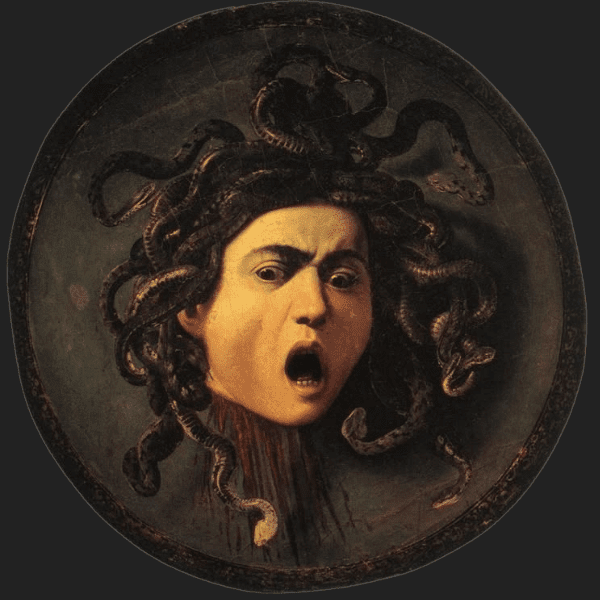When you say Medusa, the first thing that comes to mind is snakes. But let’s get one thing straight: Medusa didn’t just wake up like this. She wasn’t born with a head full of serpents. She was made this way—by rage, by gods, by injustice. And the snakes? They weren’t just for show.
But why snakes? Of all things the gods could’ve thrown at her—fire, fangs, feathers—they gave her serpents. To understand why, we’ll have to dive into myth, psychology, ancient art, and a few uncomfortable truths.
Medusa Before the Snakes

Long before the hiss of serpents echoed from her head, Medusa was just a mortal woman. Not a monster. Not yet.
She was a priestess in Athena’s temple—beautiful, devout, and powerful in her own quiet way. Some stories claim she was born human, others say she was always one of the Gorgons, but one thing remains constant: she wasn’t dangerous… until the gods made her so.
Poseidon—god of the sea and chaos—wanted her. And when gods want something in Greek mythology, they rarely ask politely. He attacked her in Athena’s sacred space. And Athena, instead of seeking justice, turned her rage on Medusa. She transformed the victim into something terrifying—her hair into snakes, her gaze into death.
The transformation wasn’t a makeover. It was a message.
Snakes as Symbols: Ancient & Alive

Snakes have always carried meanings that slither between extremes—life and death, poison and healing, power and vulnerability.
In ancient Greece, the snake was sacred. The Rod of Asclepius, symbol of medicine, features a serpent. Not because it harms—but because it heals. Snakes, in their ability to shed skin, were seen as emblems of renewal. Of starting over.
In India, Nāgas are divine serpents—protectors of water and spiritual secrets.
In Mesoamerican culture, Quetzalcoatl, the feathered serpent god, symbolized creation and knowledge.
Even in Greek mythology, the Ouroboros—the snake eating its own tail—represents infinity, the eternal cycle.
So when Athena gives Medusa snakes, she’s not just punishing her. She’s remaking her. Into something beyond mortal. Beyond male gaze. Something cyclic, wild, protective.

And don’t forget this: Medusa was the only mortal Gorgon. Her sisters were immortal. But the snakes? They made her unforgettable.
Even the number of them—how many snakes does Medusa have?—has no fixed count in myth. Which only adds to her chaotic aura. She becomes not a woman with snakes, but a force of serpentine energy.
The Snake in Psychology: From Dreams to Shadows
Now let’s enter the realm of the subconscious.
Freud, ever obsessed with male-centric fear, interpreted Medusa as a walking metaphor for castration anxiety. But we’re not doing Freud today. We’re doing Jung.

To Jung, snakes are powerful dream symbols—often connected to deep transformation, primal energy, or repressed fears. A snake in a dream might be danger. Or healing. Or desire. It might be all three.
And Medusa? She is the embodiment of the Jungian shadow—the part of the psyche that contains all we repress. She is rage silenced for too long. Power buried under shame. Wildness dressed up as sin.
When you dream of snakes, something in you is trying to awaken. When you dream of Medusa, you might be confronting the part of you that’s been told to stay quiet, stay pretty, stay safe.
Medusa snakes are not a monster. She’s a mirror. The kind that doesn’t flatter—but reveals.
A Shield, A Warning, A Weapon

So what does Medusa’s snake head represent?
For ancient warriors, it was a literal shield. Athena mounted the Medusa head on her armor—not as decoration, but as a protective talisman.
You can still see her in stone—on the Medusa head in Istanbul’s Basilica Cistern, peering sideways from the depths, protecting the city in silence.

Today, that same energy survives in modern talismans. A Medusa necklace isn’t just a fashion statement—it’s a statement of survival.
Wearing it is like saying: I’ve been through the fire. I’ve grown my fangs. Don’t come closer unless you mean it.
That’s exactly why we created our Coventum Medusa necklace. In silver color, with her serpents coiled like whispered secrets, it’s a way of wearing the myth—and owning it.
So, Why Snakes?
Because snakes transform.
Because snakes defend.
Because snakes remember.
Because no one ever truly sees the snake coming—until it strikes.
Medusa’s snakes are not a curse. They’re a crowning glory of rage, rebirth, and resistance. And maybe, just maybe, they’re the part of you that’s done being quiet.
So next time someone asks “What does the snake symbolize in Medusa?”
You can answer:
Everything she was told to hide—and refused to.
Still curious?
Read our deeper dive: Medusa: Villain or Victim?
Or wear the myth yourself: Explore our Medusa Necklace Collection


